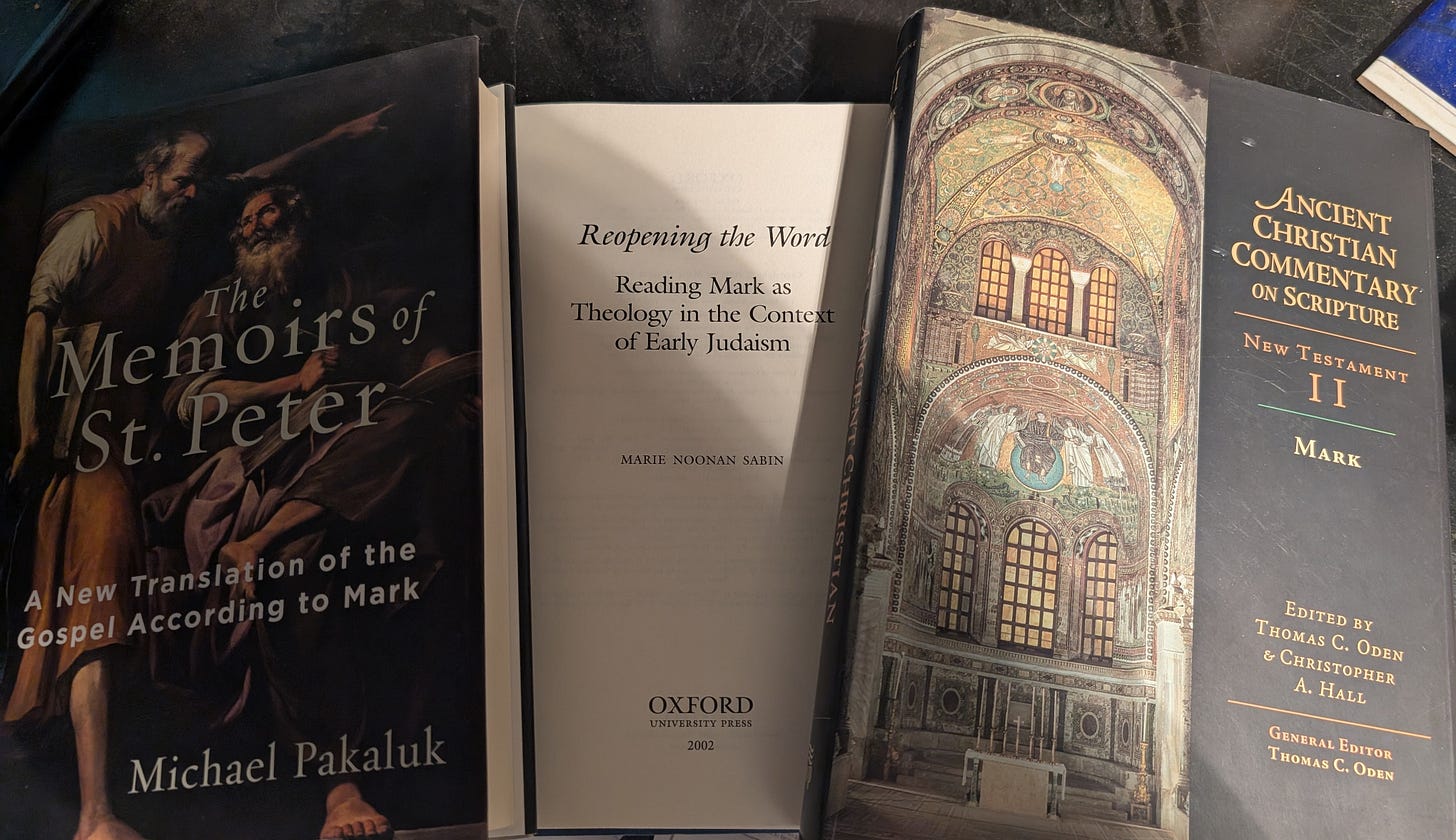The beginning of the gospel of Jesus Christ, the Son of God. (Mark 1:1)
The Gospel of Mark is up in my Morning Prayer readings.
The shortest of the four Gospels, it generates shelves (and probably libraries) of commentary on its sixteen brisk chapters.
There was a vogue at one time to tell people to start their Bible reading with Mark, to get through this punchy summary of the ministry and Passion of Jesus Christ before wading into longer, theologically denser books.
I’ve moved away from that position, although seeing Mark come up in my cycle of lessons still lifts my spirit like the return of football season. Yet as much as I love reading Mark’s account, it can be, I think, jarring to a new Christian or someone exploring the faith.
Mark does give a brief, foundational presentation of Jesus’ earthly ministry. The Gospel begins with a mere seven verses presenting John the Baptist as the fulfillment of Old Testament prophecy about a herald for God’s saving work.
Then Jesus shows up to be baptized. No star over Bethlehem, no sheep and donkeys, no shepherds and Wise Men — no Christmas Pageant here.
Then (or as Mark is fond of transitioning, “immediately”) Jesus is out in the wilderness, being tempted by Satan. This is still Chapter 1. It takes Matthew and Luke, who build on Mark as a source, four chapters to get to the temptation in the wilderness.
Mark moves from event to event, with Jesus’ teachings delivered on the go. There is little of the elaborate, lingering teaching like Matthew’s Sermon on the Mount, or Luke’s beloved parables of the Good Samaritan and the Prodigal Son, or John’s deep but helpful narration.
Not only is Mark briefer and less ruminative than the other Gospels, I would argue that it is in some ways more mystical.
The very first verse of Mark hits us with, The beginning of the gospel of Jesus Christ, the Son of God. It’s an assertion with no foundation laid, a sudden outing of our worldview as at least incomplete if not entirely incorrect. Just a few verses later, Mark doubles down, adding nothing explanatory but simply reporting, And a voice came from heaven, “You are my beloved Son; with you I am well pleased.”
The birth narratives in Matthew and Luke tell us all about Jesus’ divine nature and the unfolding of a sacred plan; John’s Prologue reveals Christ’s eternal existence and impact. All three buffer the radical news of Jesus’ identity with confused humans like ourselves receiving, pondering and processing divine explanations of what’s up — Mark just lobs in Jesus, divinity and all.
Leaping to the other end of the Gospel, Mark gives us a notorious account of Easter, which most scholars (even traditional and “conservative” ones) believe ends with fear and silence,
…they saw that the stone had been rolled back—it was very large. And entering the tomb, they saw a young man sitting on the right side, dressed in a white robe, and they were alarmed. And he said to them, “Do not be alarmed. You seek Jesus of Nazareth, who was crucified. He has risen; he is not here. See the place where they laid him. But go, tell his disciples and Peter that he is going before you to Galilee. There you will see him, just as he told you.” And they went out and fled from the tomb, for trembling and astonishment had seized them, and they said nothing to anyone, for they were afraid. (Mark 16:4-8)
The Resurrection is asserted, but there is no comforting, encouraging appearance of the risen Jesus to validate this and let us wipe our brows in relief. We are left to process an empty tomb with trembling, astonishment and fear — and like the women who were there, we might find ourselves at a loss for words.
Mark’s Gospel is known for its portrayal of Jesus’ disciples as uncomprehending (that’s a nice word for it). A theme of Mark, up to and including the empty tomb, seems to be, “You’re not getting it.”
Just about dead center in Mark, Peter has a spiritual breakthrough, which occurs as Jesus is characteristically on the move,
And Jesus went on with his disciples to the villages of Caesarea Philippi. And on the way he asked his disciples, “Who do people say that I am?” And they told him, “John the Baptist; and others say, Elijah; and others, one of the prophets.” And he asked them, “But who do you say that I am?” Peter answered him, “You are the Christ.” And he strictly charged them to tell no one about him. (Mark 8:27-30)
But this gives way to a spiritual setback, as Peter doesn’t shut up and ponder the revelation but instead asserts his own point of view,
And (Jesus) began to teach them that the Son of Man must suffer many things and be rejected by the elders and the chief priests and the scribes and be killed, and after three days rise again. And he said this plainly. And Peter took him aside and began to rebuke him. But turning and seeing his disciples, he rebuked Peter and said, “Get behind me, Satan! For you are not setting your mind on the things of God, but on the things of man.” (vv. 31-33)
As I wrote above, there’s a mystical bent to Mark, a challenge to shut up and ponder Jesus and his words and deeds — to refrain from pushing our own agendas in place of who Jesus is.
Mark is a short book, but not a read to be rushed.



This makes a person want to delve. Peace!
Thank you for this wonderful lesson.